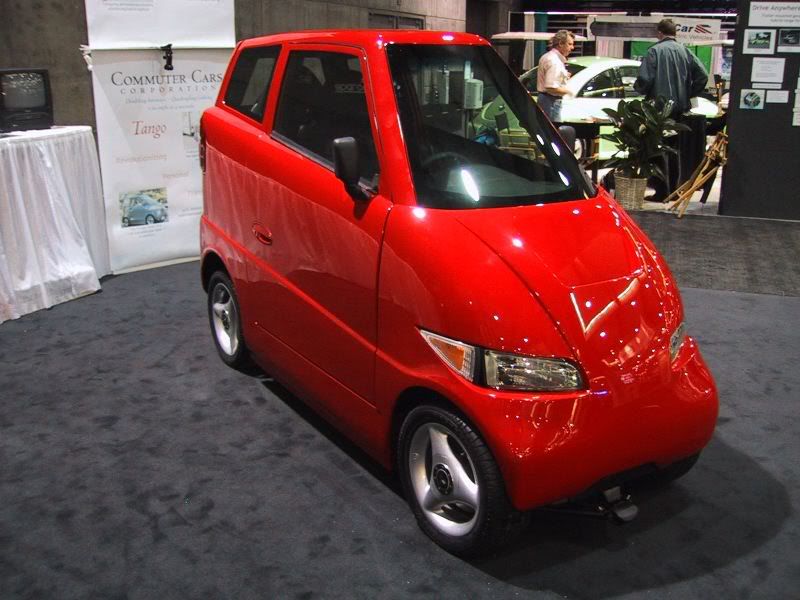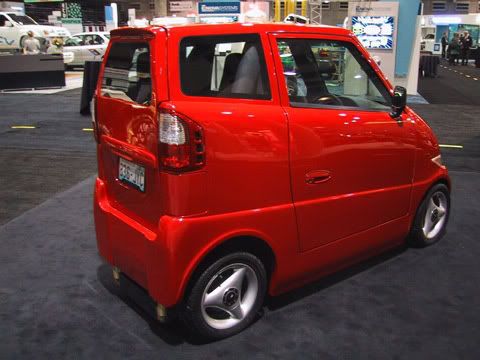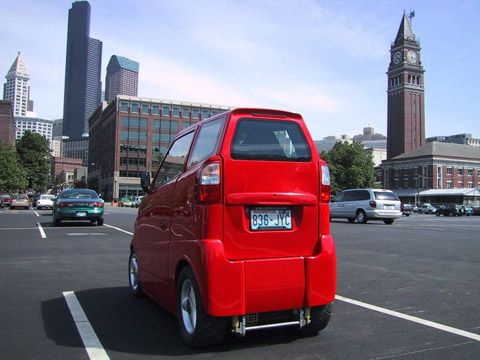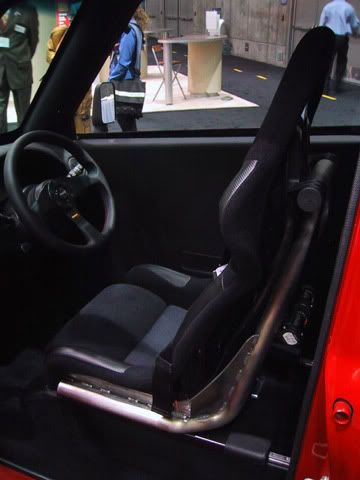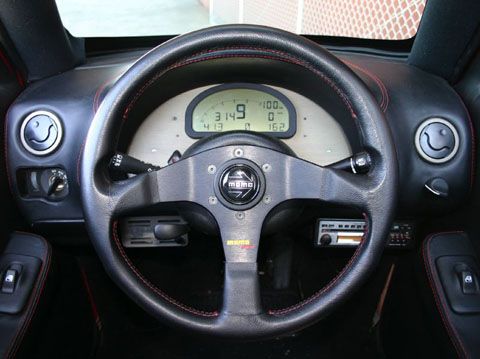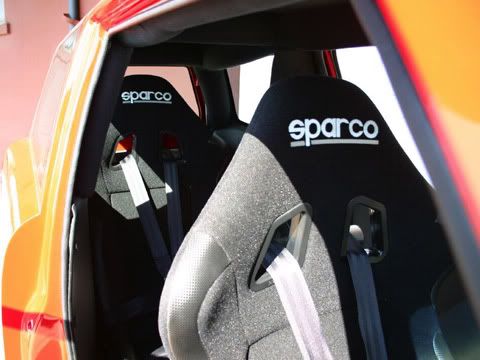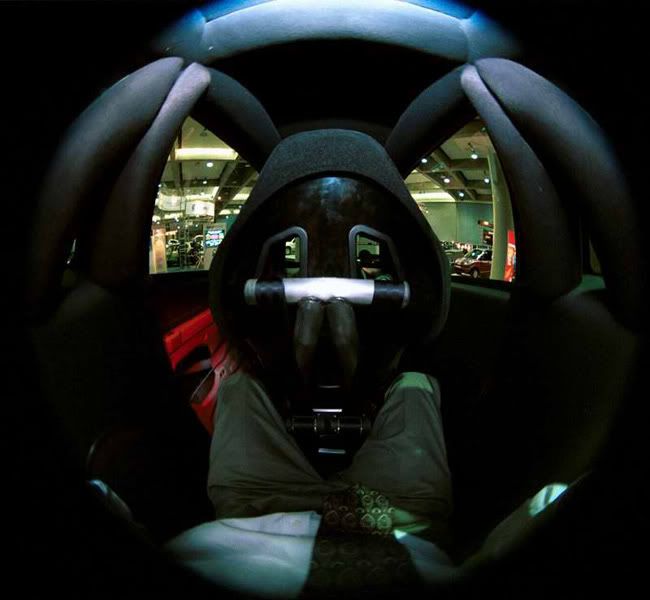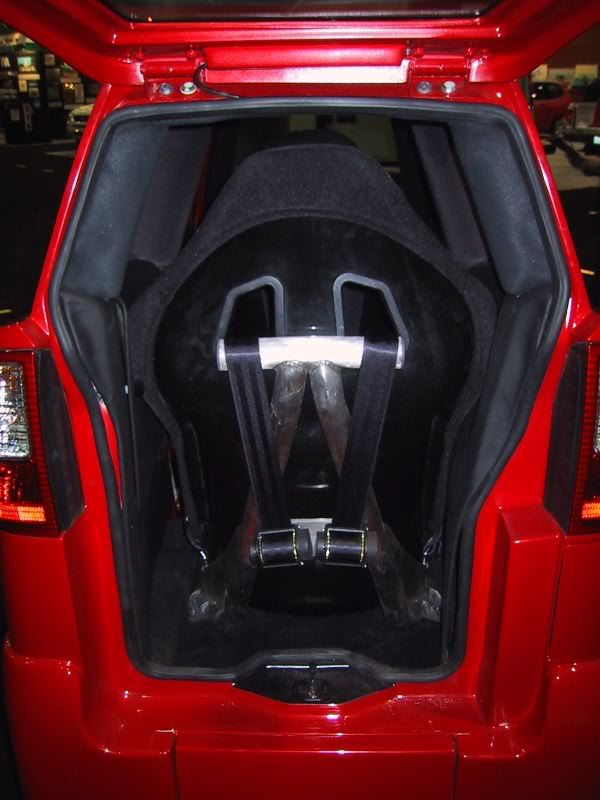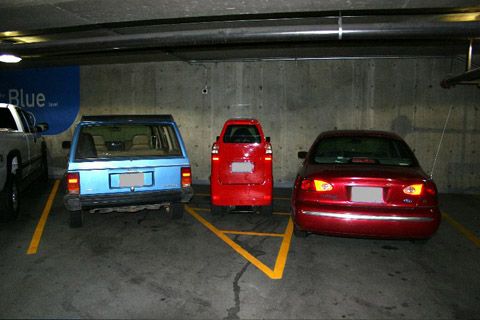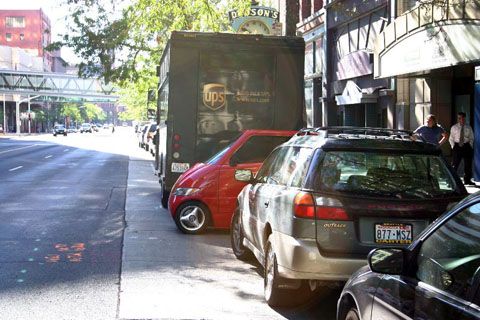Narrowband Beware
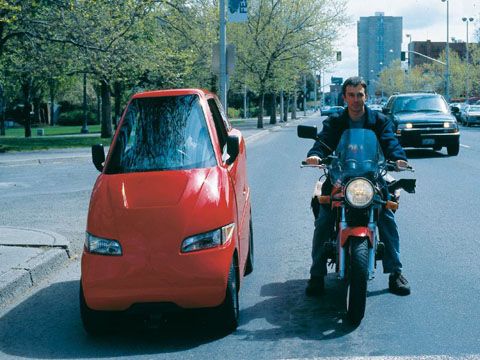
Tango
Tango T600 (kit) Specifications:
(Subject to change.)
Width:39" (5" narrower than a Honda Gold Wing)Length:8'5" long, allowing it to park perpendicular to the curb.Height:60"Ground Clearance:4"Weight:2,500 lbs.Battery Box:25 Exide Orbital XCD's or Optima Yellow Tops. Will accommodate Ni-MH and/or Li-Ion batteries in the future.Nominal Voltage:300 VDCBattery Weight:1,025 lbs (Exide) or 1,125 lbs (Optima)Charging:50 amp on-board charger with Avcon conductive coupling. 200 amp Avcon w/ on-board charger under development.Steering:Rack and pinion with Cadillac CTS collapsible steering column and Sparco Lap 5 steering wheelFront Suspension:Unequal length A-arm with coil-over Pro shocks.Rear Suspension:Trailing arm with coil-over Pro shocks.Controller:Zilla motor controller, providing up to 2,000 Amps at 300 Volts (600 kW). Designed and built by Otmar Ebenhoech at Café Electric LLC in Palo Alto, CA.Motors:2 Advanced DC FB1-4001 9" motors, one driving each rear wheel with over 1,000 ft-lb of combined torque at low rpms. 8,000 rpm redline.Transmission:2 direct drive gear boxes designed by Bert Transmission of St-Constant, Québec, the leading manufacturer of dirt circle track race car transmissions. Semi-quick-change with 10 available ratios from 2.92:1 to 5:1. Standard ratio is 3.25:1. Splined locker can be easily engaged by removing C-clip, sliding sleeve and replacing C-clip.Wheels:5.5 x 13, 3 spoke alloy, 5 bolt on 115 mm centerHubs/Wheel Bearings:As used on the Pontiac Bonneville and some Cadillacs.Front Tires:BF Goodrich Euro T/A 175/50R13 M+SRear Tires:Yokohama Advan A032R P215/50R13 (H Compound): Yokohama's ultimate DOT-approved racing tire.
Brakes:Acura Integra disk brake calipers front and rear (with integrated parking brake). Wilwood 5/8" dual master cylinders with Wilwood balance bar pedal assembly for front/rear biasing.HVAC:12,000 BTU Vintage Air air conditioning system driven by variable speed AC motor for predictable climate control. 3,000 W electric heater for instant-on, powerful heating.Seating:Tandem Sparco Roadster bucket seats with attached 4-point harness structures. Passenger straddles the front seat and harness structures which do not interfere with the passenger's knees.Storage:Passenger and a few bags of groceries with rear seat installed. Removed, it allows seven 10-ream cartons of paper with the driver's seat in extended position. (Rear seat with harness structure is easily removable through rear hatch.) Multiple compartments for smaller items.Headroom:39" driver and passenger.Trailer Hitch:Accepts standard 1" for towing generator cart for extended range. Note: Projected performance specifications may vary somewhat depending on final weight and batteries used.Range:60-80 milesCost per Mile:About 1/2 the cost of a gasoline car for the average commuter. (See note.)Acceleration:0 to 60 MPH, about 4 seconds. 1/4 mile time about 12 seconds at a speed of approx. 120 MPH (See note.)Top Speed:150 MPH (See note.)
Notes:
Cost per Mile:
The average round-trip commute in the U.S. is 20 miles according to the 2000 report from the Bureau of Transportation Statistics.
For that average commute of 20 miles and up to 24 miles per charge, the total cost per mile of the Tango is approximately 30% lower than that of a Honda Insight. This includes battery replacement, maintenance, and the cost of electricity at $.05 per kWh (as in the Northwest). The Honda Insight has an EPA rating of 56 mpg city and 57 highway. This spreadsheet shows how the Tango compares with other vehicles, both Internal Combustion Engine (ICE) driven and hybrid. It includes gasoline and recommended dealer maintenance costs for the gasoline cars and electricity, maintenance, and battery replacement costs for the Tango.
In California where electricity rates are nearly $.15 per kWh, the total cost per mile for the Tango becomes roughly equal to that of the Insight. Electricity cost per mile runs from 0.9 cents to 2.6 cents as cost per kWh goes from 5 cents to 15 cents.
Battery replacement is the largest portion of the cost-per-mile for an electric car. To demonstrate how this works, we use Optima's cycle life vs. depth of discharge graph. This graph applies to laboratory-controlled charge and discharge cycles, yet is quite indicative of the effects of driver habits. If the Tango were driven to 80% DOD (depth of discharge) or more (approximately 64 to 80 miles regularly between charges), the pack will only yield 250 cycles. This works out to approximately 16 cents per mile with current Optima Yellow Top prices of $100. However, if discharged to 25% DOD (20 to 24 miles between charges), the chart shows 4,000 cycles can be achieved yielding 80,000 miles with a cost of only 3.1 cents per mile.
Acceleration:
0 to 60 MPH, about 4 seconds. 1/4 mile time about 12 seconds at a speed of approximately 120 MPH. These figures are based on comparisons with other cars that hold official records with NEDRA (National Electric Drag Racing Association). Calculations have taken weight, motor torque, controller, voltage, gear ratio, and traction into consideration. They assume that the vehicle is driven on a drag strip with good traction conditions. For example, the world record held for a dragster used the same controller as the Tango in the Current Eliminator IV, with a quarter mile time of 8.801 seconds at 137.65 MPH. The Tango has the same motors that the Maniac Mazda used to achieve an 11.039 second quarter mile at 111.80 MPH.
Top Speed:
150 MPH. This is a limitation based on a practical red-line for the motors of about 8,000 RPM with the standard 3.25:1 gear ratio. Top speed vs. acceleration can be traded off by choosing any of 10 different ratios from 2.92:1 giving a top speed of 172 MPH to 5:1 which would give a top speed of 100 MPH. The 5:1 would give phenomenal acceleration if you could get enough traction.
